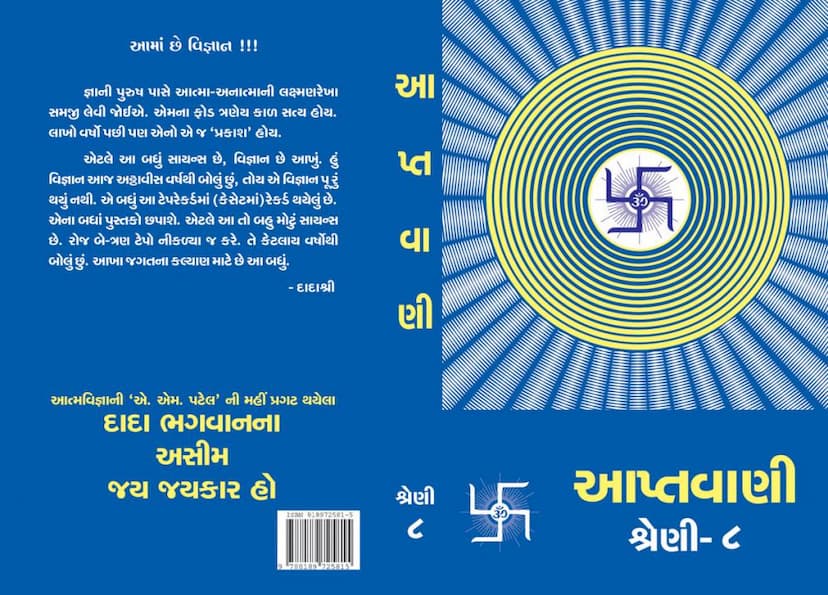Aptavani 08
Added to library: September 1, 2025

Summary
The text "Aptavani 08" by Dada Bhagwan is a collection of spiritual discourses and question-and-answer sessions focused on Jain philosophy, particularly the path to liberation (moksha) as understood through the teachings of Dada Bhagwan, who is considered a manifestation of the Self (Atma) in the lineage of the Tirthankaras.
Here's a comprehensive summary of the key themes and concepts discussed in the provided text:
1. The Science of the Self (Atma):
- The text emphasizes that Dada Bhagwan's teachings reveal the "science of the Self" (Atma Vigyan), which is presented as a complete and eternal science.
- The distinction between the Self (Atma) and the non-Self (Anatma) is crucial. Dada Bhagwan is portrayed as the Knower who has seen and understood this distinction, offering this knowledge to seekers.
- The teachings are described as "science" and "knowledge," not mere philosophy or belief, implying a practical and verifiable understanding of reality.
2. The Nature of the Self (Atma):
- Eternal and Unchanging: The Self (Atma) is described as eternal, unchanging, and unaffected by the changes in the physical body or the world. It is the underlying reality that persists through birth and death.
- Consciousness (Chetan): The Self is fundamentally consciousness (Chetan). It is the source of knowledge and awareness.
- Infinite Qualities: The Self possesses infinite knowledge, infinite perception, infinite power, and infinite bliss. It is inherently pure and complete.
- Not Physical: The Self is described as formless (Nirakar) and beyond sensory perception. It cannot be seen, touched, or measured by material means.
- The True "I": The core message is to recognize the Self as the true "I," distinct from the body, mind, intellect, and ego.
3. The Nature of the Non-Self (Anatma) and the World:
- Transient and Changing: Everything that is visible, perceivable by the senses, and subject to change is considered non-Self (Anatma). This includes the body, thoughts, emotions, and the external world.
- Maya and Illusion: The world and its phenomena are often described as illusions (Maya) or temporary adjustments (Temporary Adjustments) that veil the true nature of the Self. The "wrong beliefs" (Wrong Beliefs) about the Self being the body or the ego are considered the primary cause of suffering and bondage.
- The Six Elements: The universe is composed of six eternal elements (Shad Tatva) that are in constant interaction, creating the various states of existence.
4. The Path to Self-Realization (Atma Sakshatkar):
- The Role of the Gnani Purush: The central theme is the indispensability of the Gnani Purush (the Enlightened One, Dada Bhagwan in this context). Only a Gnani Purush, who has realized the Self, can bestow the direct experience of the Self.
- Akram Vigyan (The Un-step-by-step Science): Dada Bhagwan's teachings are characterized as "Akram Vigyan," an effortless and direct path to Self-realization, bypassing the step-by-step methods of traditional spiritual paths. It is described as a "lift" to liberation, as opposed to climbing stairs.
- Right Belief (Right Belief): The key to liberation lies in eradicating "wrong beliefs" and establishing "right beliefs" through the grace of the Gnani Purush. This involves understanding the Self and the non-Self accurately.
- Shifting Perspective (Drashti): Self-realization is achieved by shifting one's perspective from the external (Anatma) to the internal (Atma). The Gnani Purush facilitates this shift in vision.
- Intention (Bhavna): The ultimate goal is to reach the state of "Samadhi" (equanimity) and live in one's inherent nature (Swadharma). The driving force behind this is the pure intention (Bhavna) of the Gnani Purush to benefit all beings.
5. Key Concepts Explained:
- Karma: Karma is explained through the concept of "planning" (Yojana) in previous lives leading to "manifestation" (Roopak) in the current life. Actions performed with the belief of "I am the doer" (Karta) create new karma, while understanding "It happens" (It Happens) and the Self as the witness leads to liberation from karma.
- Birth and Death: Birth and death are attributed to the ego (Ahankar) and "wrong beliefs," not the Self, which is unborn and immortal. The cycle of birth and death is a process of shedding and acquiring new forms based on karma and beliefs.
- The Nature of God: God (Bhagwan) is not seen as a creator in the conventional sense but as the inherent energy within every living being, manifesting as consciousness. The Gnani Purush is the embodiment of the formless (Nirakar) within the form (Sakkar).
- Dwaita (Duality) and Advaita (Non-duality): The text clarifies that the Self is neither truly dual nor non-dual but "Vaitadvaita" (which transcends both concepts). The perceived duality arises from the presence of the body and relative viewpoints, while the Self in its pure state is beyond these descriptions.
- The Goal of Life: The ultimate purpose of human life is to attain liberation (Moksha), which is the realization of one's true Self and the subsequent state of eternal bliss and freedom from suffering.
6. Addressing Common Spiritual Queries: The text addresses numerous questions regarding:
- The existence and nature of the soul.
- The difference between the soul and the body.
- The concept of karma, reincarnation, and the cycle of birth and death.
- The nature of consciousness, God, and the universe.
- The practical application of spiritual knowledge in daily life.
- The limitations of intellectual understanding versus direct experiential knowledge.
Overall Message: The book, "Aptavani 08," serves as a guide to understanding the ultimate reality of the Self through the direct and practical teachings of Dada Bhagwan. It aims to dispel illusions and wrong beliefs, leading the seeker to the direct realization of their true, pure, and blissful nature as the Self (Atma). The core message is that Self-realization is achievable in this lifetime through the grace of a Gnani Purush and by embracing the Akram path of Self-knowledge.